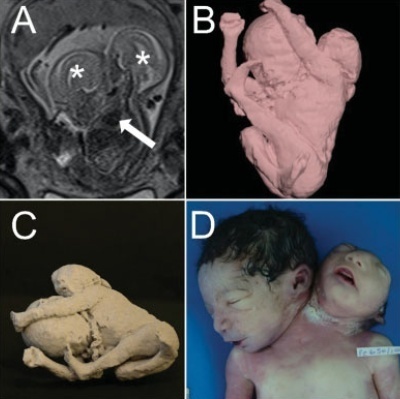-
Case Report
Antenatal Diagnosis of Parapagus Conjoined Twins: 3D Virtual and 3D Physical Models
Revista Brasileira de Ginecologia e Obstetrícia. 2021;43(12):985-987
01-24-2021
Summary
Case ReportAntenatal Diagnosis of Parapagus Conjoined Twins: 3D Virtual and 3D Physical Models
Revista Brasileira de Ginecologia e Obstetrícia. 2021;43(12):985-987
01-24-2021Views144See moreAbstract
Conjoined twins (CTs) are a rare complication from monochorionic and monoamniotic twin pregnancies. We describe the use of 3D technologies, including 3D virtual and 3D physical models on prenatal evaluation of one parapagus CT. A 16-year-old G1P0 woman was referred for fetal magnetic resonance imaging (MRI) anatomical evaluation of a CT at 28 weeks of gestation. 3D images of the fetal surface were generated by the software during the examination for spatial comprehension of the relationship between the fetal parts. The pair of CTs died at the 32nd week of gestation, a few hours after cesarean section. 3D technologies are an important tool for parental counseling and preparation of the multidisciplinary care team for delivery and neonatal assistance and possible surgical planning for postnatal separation in CTs cases.

-
Artigos Originais
Conjoined twins: prenatal diagnosis, delivery and postnatal outcome
Revista Brasileira de Ginecologia e Obstetrícia. 2011;33(5):211-218
08-15-2011
Summary
Artigos OriginaisConjoined twins: prenatal diagnosis, delivery and postnatal outcome
Revista Brasileira de Ginecologia e Obstetrícia. 2011;33(5):211-218
08-15-2011DOI 10.1590/S0100-72032011000500002
Views111See morePURPOSE: the aim of this study was to analyze conjoined twins in terms of antenatal, delivery and postnatal aspects. METHODS: a retrospective descriptive analysis of prenatally diagnosed conjoined twins. Prenatal ultrasound and echocardiography, delivery details, postnatal follow-up, surgical separation and post mortem data were reviewed. The twins were classified according to the type of fusion between fetal structures. The following data were analyzed: ultrasound and echocardiographic findings, antenatal lethality and possibility of surgical separation, delivery details and survival rates. RESULTS: forty cases of conjoined twins were included in the study. There were 72.5% cases of thoracophagus, 12.5% of paraphagus, 7.5% of omphalo-ischiophagus, 5.0% of omphalophagus, and 2.5% of cephalophagus. Judicial termination of pregnancy was requested in 58.8% of the cases. Cesarean section was performed in all cases in which pregnancy was not terminated. The mean gestational age at delivery was 35 weeks; all twins were live births with a mean birth weight of 3,860 g and 88% died postnatally. Ten percent of the live borns were submitted to surgical separation with a 60% survival rate. The total survival rate was 7.5% and postnatal survival was 12%. Antenatal evaluation of lethality and possibility of surgical separation were precise. There were no maternal complications related to delivery. CONCLUSION: conjoined twins present a dismal prognosis mainly related to the complex cardiac fusion present in the majority of cases with thoracic sharing. At referring centers, prenatal ultrasound and echocardiographic evaluation accurately delineate fetal prognosis and the possibility of postnatal surgical separation.


